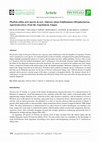Papers by Bernardo Lechner
Romano, G. M.; J. A. Calcagno & B. E. Lechner. 2013. Biodiversity of Agaricomycetes basidiomes as... more Romano, G. M.; J. A. Calcagno & B. E. Lechner. 2013. Biodiversity of Agaricomycetes basidiomes associated to Salix and Populus (Salicaceae) plantations. Darwiniana, nueva serie 1(1): 67-75.
Cryptogamie, Mycologie, 2011
ABSTRACT
Macro- and micromorphological charac- ters of specimens of the genus Pleurotus (Fr.) P. Kumm. in ... more Macro- and micromorphological charac- ters of specimens of the genus Pleurotus (Fr.) P. Kumm. in Argentina obtained in the field and from different national herbaria were analyzed. Cultivation techniques were used to obtain basidiomata, allowing for a macro- and micromorphological study of fresh developing fruit bodies. We concluded that in Argen- tina there are, so far, six species, namely P.

We present a study on the genus Pholiota sect. Adiposae stirps Subflammans from the Republic of A... more We present a study on the genus Pholiota sect. Adiposae stirps Subflammans from the Republic of Argentina. Pholiota oblita is proposed as a new species. It is characterized by its narrow lamellae, elongated cheilocystidia and broad spores. Singer originally described this species as P. digilioi, but this name was never validly published. Pholiota oblita is close to P. flammans, from the Northern Hemisphere, and P. subflammans, from the South American Andino-Patagonic forest,but differs by the diagnostic characters previously mentioned . The species was found in the southern end of the Yungas Forest, a cloud forest located on the eastern slopes of the sub-Andean mountains. Numerous collections of P. oblita were found in the Yungas forest but not in other areas. We believe that it could be an endemic species. Furthermore, we found that there are no herbarium specimens for the type of Pholiota subflammans (Speg.) Sacc. With the absence of original material, and to preserve current usag...
Five new species of Pouzarella are described from northern Argentina, P. brunneonigrescens, P. ol... more Five new species of Pouzarella are described from northern Argentina, P. brunneonigrescens, P. olivacea, P. parvispora, P. sulcata and P. variabilis. Pouzarella ferreri var. ferreri is also reported for the first time from Argentina. All known Pouzarella species reported from Argentina are discussed and a key to species is provided. Se describen e ilustran cinco nuevas especies de Pouzarella del norte argentino, P. brunneonigrescens, P. olivacea, P. parvispora, P. sulcata y P. variabilis. Pouzarella ferreri var. ferreri es citada por primera vez para la Argentina. Se discuten todas las especies conocidas de Pouzarella para la Argentina y se propone una clave para su identificación
Darwiniana
Although plantations have an artificial origin, they modify environmental conditions that can alt... more Although plantations have an artificial origin, they modify environmental conditions that can alter native fungi diversity. The effects of forest management practices on a plantation of willow (Salix) and poplar (Populus) over Agaricomycetes basidiomes biodiversity were studied for one year in an island located in Paraná Delta, Argentina. Dry weight and number of basidiomes were measured. We found 28 species belonging to Agaricomycetes: 26 species of Agaricales, one species of Polyporales and one species of Russulales. Our findings suggest that forest management practices on plantations of willow and poplar do not affect either the abundance or diversity of Agaricomycetes basidiomes.

La isla Talavera está localizada dentro de la Reserva de Biosfera Delta del Paraná, provincia de ... more La isla Talavera está localizada dentro de la Reserva de Biosfera Delta del Paraná, provincia de Buenos Aires, Argentina. El ambiente de humedad constante en las plantaciones de álamos y sauces existentes en la región es un escenario ideal para el desarrollo de hongos macroscópicos. Estos hongos son, en general, saprobios y lignocelulolíticos, y la formación de ascomas y basidiomas dependen, en gran parte, del agotamiento de los nutrientes presentes en el sustrato y de las condiciones óptimas de temperatura y humedad. El estudio comprendió muestreos cada 15 días durante 9 meses desde abril hasta diciembre de 2010. Se tomaron 2 áreas de 1000 metros cuadrados, una correspondiente a una zona que es talada cada 4 a 6 años y otra correspondiente a una zona que no ha sido talada en los 30 años transcurridos desde su implantación. Estas dos áreas seleccionadas se subdividieron en 40 sectores, de los cuales se seleccionaron 10 al azar para realizar los muestreos. Todos los ejemplares colecc...

El conocimiento de la biodiversidad fúngica es esencial para la caracterización y entendimiento d... more El conocimiento de la biodiversidad fúngica es esencial para la caracterización y entendimiento de los ecosistemas, ya que cumplen un rol por demás importante como descomponedores y recicladores de materia orgánica. Los estudios ecológicos relacionados con la biodiversidad de hongos son escasos y sólo una porción menor aprovecha el manejo de la explotación forestal para estudiar la misma en relación a dicha actividad. Hasta la fecha no existen trabajos que vinculen la biodiversidad de hongos con el manejo forestal en la Argentina. En la Reserva de Biosfera Delta del Paraná, un 20 % de la superficie total es aprovechada para el cultivo de sauces (Salix sp.) y álamos (Populus sp.), y constituye el marco físico más importante para que éstos sean explotados con fines comerciales, siendo esta la principal actividad de la región. Las condiciones meteorológicas, como la amplitud térmica, dirección e intensidad de los vientos y cantidad de precipitaciones, modifican constantemente el nivel ...
Sydowia -Horn-
In order to study the sexual compatibility, monosporic cultures from 32 strains belonging to four... more In order to study the sexual compatibility, monosporic cultures from 32 strains belonging to four out of the six Pleurotus species recorded from Argentina were obtained. All tested species have a heterothallic multifactorial tetrapolar mating system. P. pulmonarius and P. ostreatus could be separated by interspecific crossings only. Our mating tests confirm the synonymy of P. smithii with P. cystidiosus. Compatibility tests confirm that in Argentina there are, so far, 5 Pleurotus species, namely P. albidus, P. cystidiosus, P. djamor, P. ostreatus and P. pulmonarius.
Etymology: from xúavoc (Greek) = blue. Refers to blue lamellae. Pileus leviter campanulatus vel a... more Etymology: from xúavoc (Greek) = blue. Refers to blue lamellae. Pileus leviter campanulatus vel applanatus, brunneis, glabrous, 30-40 mm diam., 20 mm altus. Lamellae cyanescentes, 2-3 mm amplitudine, parvis incrassatae, pulverulentibus in sicco. Stipes longus, 85-120 × 2-4 mm, aliquantum helicoides, compactus, glabrous, pulverulentus sub lente, niveus. Pileipellis cellulis claviformibus, perpendicularibusque exornatus, 29-68 × 11-20 µm. Contextus hyphis fibulatis, hyalinis, fragillibus, parietibus parce incrassatis, parce ramosis, 2.6-13 µm diam. formantibus. Stipitipellis in cutis cum fasces hyphis afibulatis, parce incrassatis, parallelis, 2.6-10 µm diam. Basidia 60-70 × 11-14 µm, 2-sporulatis, raro 1-3-4sporulatis, sterigmata usque ad 10 µm long. Sporis grosse aculeatis, hyalinis, globosis, 10-20 µm diam. (cum spinis).
Persoonia - Molecular Phylogeny and Evolution of Fungi
The paper takes up four points: 1) A previous1y unnamed intersteri1ity group in Pleurotus (ISG XI... more The paper takes up four points: 1) A previous1y unnamed intersteri1ity group in Pleurotus (ISG XIII) has been identified as P. albjdus, which fruits from Central America to central Argentina. The species is genetica11y iso1ated and phy1o-genetica11y it is p1aced in the .P. ostreatus' group of monomitic Pleurotus basidio-mata. 2) The distributiona1 range of P. abjetjcola is extended to far northwestem Russia and northem China. 3) A partia1 nomenc1ator is fumished for P. djamor 4) The use of the term .dirnitic' is discussed as it pertains to Pleurotus
Summary: Mushrooms are not usually included in the traditional eating habits of the Argentine peo... more Summary: Mushrooms are not usually included in the traditional eating habits of the Argentine people. Nevertheless, there are some people that consume wild species. This practice has caused the poisoning of an important number of adults and children in the last years. In the present paper we describe the poisonous mushroom Amanita pantherina as a new record for Argentina and we provide a key for the identification of the species of Amanita belonging to Secc. Amanita found in our country. We also describe and reevaluate the edibility of Tricholoma equestre, which has been found to cause a new poisoning syndrome. This species was recently prohibited in some countries of Europe.
Revista Iberoamericana de Micología
Specimens belonging to the genus Pleurotus were collected growing on fallen trunks of Araucaria a... more Specimens belonging to the genus Pleurotus were collected growing on fallen trunks of Araucaria araucana, a native tree with a poorly known mycoflora, which grows in Patagonia, Argentina. Fruitbodies were produced in culture on sawdust from an isolated strain. Interspecific pairing tests performed between mating types of Pleurotus from Patagonia and tester strains of P. pulmonarius and P. ostreatus showed the Patagonia strain to be 100% compatible with P. ostreatus and incompatible with P. pulmonarius. Dikaryons obtained on sawdust were fertile, since they were able to produce fruitbodies and viable spores. This is the first documented record of P. ostreatus from Argentina and the first gilled fungus found growing on Araucaria araucana.











Uploads
Papers by Bernardo Lechner